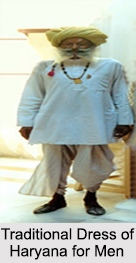 Traditional dress of Haryana is vibrant and colourful which expresses their culture, tradition and lifestyle. For men, traditional dress of Haryana is dhoti-kurta-pagri and women of the state wear kurti-ghagra-odhni. Below are the details about the traditional dresses of Haryana to showcase their culture and tradition.
Traditional dress of Haryana is vibrant and colourful which expresses their culture, tradition and lifestyle. For men, traditional dress of Haryana is dhoti-kurta-pagri and women of the state wear kurti-ghagra-odhni. Below are the details about the traditional dresses of Haryana to showcase their culture and tradition.
Traditional Dress of Haryana for Men
Dhoti is the pure traditional attire for the Haryanvi men. It is a long piece of cloth which is worn by wrapping around the waste and tucking in the middle of the waste line. Most of the time, the colour of the dhoti is white. Along with dhoti, men wear kurta of white colour. For Haryanvi men wearing white dhoti and kurta is a status symbol. Pagri is a turban or a headgear for the men. It is a rolled piece of long cloth, which is wrapped around the head. However, in recent times, only older villagers wear pagri. Traditional footwear of Haryana for men is Jutti. Juttis are similar to mojaris. It is closed shoes only till front half of the feet and thus it is easy to wear. Juttis is made out of leather with various designs on them; even jutti made out of jute is also famous. During winters, men of Haryana are found with blankets called chaddar, which are draped over one of their shoulders.
 Traditional Dress of Haryana for Women
Traditional Dress of Haryana for Women
Haryanvi women wear kurti-ghagra-odhni. Kurta is like a shirt, which is made out of cotton and the sleeves are generally long. Kurti is generally white coloured. The Ghagra is mainly called Daaman in Haryana. It is a long, free, flared skirt having different patterns and designs on it. Different kinds of bright colours are used on them. They may also have a border at the bottom end. Odhni or chunder is an elongated piece of cloth that women wear over their attire. The chunders have colourful borders with different patterns. Women use one end of the chunder to cover their head and the other end is tucked in their waistline in the front. Women belonging to Ahir community wear Angia with Lehangas. Angia is a tight fitting blouse that women were to cover their torsos. The blouses come only just halfway on the torso.





















